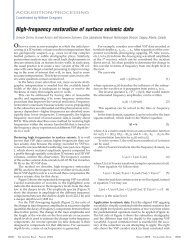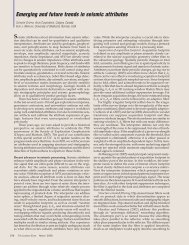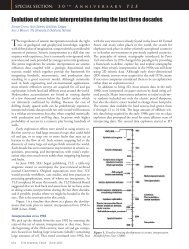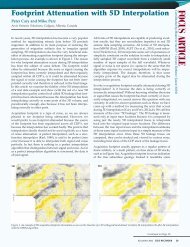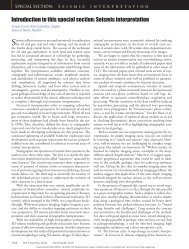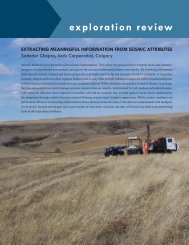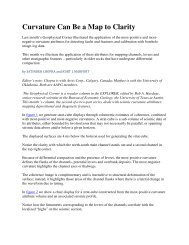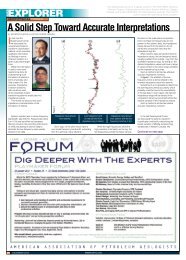Volumetric curvature attributes add value to 3D seismic data ... - Arcis
Volumetric curvature attributes add value to 3D seismic data ... - Arcis
Volumetric curvature attributes add value to 3D seismic data ... - Arcis
- No tags were found...
You also want an ePaper? Increase the reach of your titles
YUMPU automatically turns print PDFs into web optimized ePapers that Google loves.
<strong>Volumetric</strong> <strong>curvature</strong> <strong>attributes</strong> <strong>add</strong> <strong>value</strong> <strong>to</strong> <strong>3D</strong> <strong>seismic</strong> <strong>data</strong>interpretationSATINDER CHOPRA, <strong>Arcis</strong> Corporation, Calgary, CanadaKURT J. MARFURT, University of Hous<strong>to</strong>n, USAHorizon-based <strong>curvature</strong><strong>attributes</strong> have been used in<strong>seismic</strong> <strong>data</strong> interpretationfor predicting fracturessince 1994 when Lisle demonstratedthe correlation of<strong>curvature</strong> <strong>value</strong>s <strong>to</strong> fracturesmeasured on an outcrop.Different measures of<strong>curvature</strong> (such as Gaussian,strike, and dip) havebeen shown by differentworkers <strong>to</strong> be highly correlatedwith fractures, andmany more applications arealso possible. By definition,all such applications needthe interpretation of a <strong>seismic</strong>horizon, which may besimple if <strong>data</strong> quality isgood and the horizon ofinterest corresponds <strong>to</strong> aprominent impedance contrast.In contrast, horizonspicked on noisy <strong>seismic</strong><strong>data</strong> contaminated by backscatterednoise and/oracquisition footprint, orpicked through regionswhere no consistent impedancecontrast exists, can lead <strong>to</strong> inferior <strong>curvature</strong> measures.One partial solution <strong>to</strong> noisy picks is <strong>to</strong> run a spatialfilter over them, taking care <strong>to</strong> remove the noise yet retainthe geometric detail.A significant advance in the area of <strong>curvature</strong> <strong>attributes</strong>is the volumetric estimation of <strong>curvature</strong> at different wavelengthsintroduced by Al-Dossary and Marfurt (2006). Thisvolumetric estimation of <strong>curvature</strong> alleviates the need forpicking horizons for regions in which no continuous surfaceexists. This paper reports our investigations in<strong>to</strong> bothhorizon-based and volumetric <strong>curvature</strong> attribute applications.A key point is that, even after careful spatial filtering,horizon-based <strong>curvature</strong> estimates may still suffer from artifacts.Conversely, <strong>curvature</strong> attribute <strong>value</strong>s extracted from<strong>curvature</strong> attribute volumes along the same horizons yielddisplays free of artifacts and make more geologic sense.Attributes and structure-oriented filtering. The purpose offiltering along <strong>seismic</strong> events is <strong>to</strong> remove noise and enhancelateral continuity. This can be done by differentiatingbetween the dip/azimuth of the reflec<strong>to</strong>r and that of theunderlying noise. Once the dip/azimuth has been estimated,a filter can enhance signal along the reflec<strong>to</strong>r, much as interpretersdo with time/structure and amplitude extractionmaps using interpretation workstation software. The familiarfilters are the mean, median, and trimmed mean. WhileFigure 1. Two segments of a <strong>seismic</strong> section (a) before and (b) after the application of structure-oriented pcfiltering from a <strong>3D</strong> <strong>seismic</strong> volume from Alberta, Canada. Notice the cleaner background and focused amplitudesof the <strong>seismic</strong> reflections after pc filtering as well as the preserved fault edges.The subject of this article is covered more extensivelyin SEG’s newest publication, Seismic Attributes forProspect Identification andReservoir Characterization, byChopra and Marfurt. This456-page book introducesthe physical basis, mathematicalimplementation,and geologic expression ofmodern volumetric <strong>attributes</strong>including coherence,dip/azimuth, <strong>curvature</strong>,amplitude gradients, <strong>seismic</strong>textures, and spectraldecomposition. Availablenow at www.seg.org.these do a good job enhancing the signal-<strong>to</strong>-noise ratio ofthe <strong>data</strong>, they smear faults.Hoecker and Fehmers (2002) <strong>add</strong>ress this problem byusing an “anisotropic diffusion” smoothing algorithm. Theanisotropic part is so named because the smoothing takesplace parallel <strong>to</strong> the reflec<strong>to</strong>r, while no smoothing takesplace perpendicular <strong>to</strong> the reflec<strong>to</strong>r. Most important, no856 THE LEADING EDGE JULY 2007
Figure 2. Time slices (at 1232 ms) from the <strong>seismic</strong> volume generated (a) before and (b) after structure-oriented pc filtering of <strong>data</strong>, shown inFigure 1, but from a different portion of the survey. Notice the reduced background noise and focused edges of the features on these time slicesafter pc filtering.Figure 3. Segment of a <strong>seismic</strong> section from a <strong>3D</strong> <strong>seismic</strong> volume from northeastern British Columbia, Canada (a) before and (b) after applicationof structure-oriented pc filtering. Notice the cleaner background and focused amplitudes of the <strong>seismic</strong> reflections after pc filtering as well as thepreserved fault edges. Time slices (at 1576 ms) from the <strong>seismic</strong> volume generated (c) before and (d) after pc filtering of the <strong>data</strong> shown in Figures3a and b. The position of the <strong>seismic</strong> lines shown above is indicated with dotted lines. Notice the reduced background noise and focused edges ofthe features on these time slices after pc filtering.JULY 2007 THE LEADING EDGE 857
Figure 4. Time slice from a <strong>3D</strong> <strong>seismic</strong> volume from Alberta, Canada (a) before and (b) after structure-oriented pc filtering. The equivalent coherenceattribute slices are shown in Figures 4c and d; notice that Figure 4d is a cleaner display with crisper features.Figure 5. Fractional derivatives visualizedas filters applied <strong>to</strong> the conventional firstderivativeopera<strong>to</strong>r. The idealized derivativeis proportional <strong>to</strong> the wavenumber (k) andinversely proportional <strong>to</strong> the wavelength (λ).The dotted line represents a filter applied <strong>to</strong>the derivative opera<strong>to</strong>r δ/δx that wouldperfectly reproduce δ/δx. Any numericalopera<strong>to</strong>r needs <strong>to</strong> go <strong>to</strong> zero at Nyquist, orλ=2∆x. We compensate for coarser samplingartifacts at 45° <strong>to</strong> the grid by tapering thederivative after λ=4∆x. The 0.80 derivativeslightly enhances the long wavelength components,while the 0.25 derivative greatlyenhances the long wavelength components.The filters are normalized such that the areaunder the filtered spectrum (the product ofthe filter times the idealized first derivative)is equal <strong>to</strong> 1.0.858 THE LEADING EDGE JULY 2007
Figure 6. (a) Time surface from a<strong>3D</strong> <strong>seismic</strong> <strong>data</strong> volume fromAlberta, (b) most-positive <strong>curvature</strong>display for the time surface in(a), (c) most-negative <strong>curvature</strong>display for the time surface in (a).Arrows indicate some artifacts onthe attribute slices.Figure 7. (a) Most-positive <strong>curvature</strong> display extracted from the attribute volume along the time surface in Figure 6a, (b) most-negative <strong>curvature</strong>display extracted from the attribute volume along the time surface in Figure 6a. Artifacts are suppressed on these slices.smoothing takes place if a discontinuity is detected, therebypreserving the appearance of major faults and stratigraphicedges. Luo et al.’s (2002) edge-preserved filtering proposeda competing method that uses a multiwindow (Kuwahara)filter <strong>to</strong> <strong>add</strong>ress the same problem. Both approaches use amean or median filter applied <strong>to</strong> <strong>data</strong> <strong>value</strong>s that fall withina spatial analysis window with a thickness of one sample.Marfurt (2006) describes a multiwindow (Kuwahara)principal component filter that uses a vertical window of<strong>data</strong> samples <strong>to</strong> compute the waveform that best representsthe <strong>seismic</strong> <strong>data</strong> in the spatial analysis window. Seismicprocessors may be more familiar with the principal componentfilter as the equivalent Kohonen-Loeve (or simplyKL) filter. In this paper, we use 99 nine-trace, ±10-ms (11-sample) analysis windows parallel <strong>to</strong> the dip/azimuth thatcontains the analysis point of interest. We then apply ourprincipal component (pc) filter <strong>to</strong> the analysis point usingthe window that contains the most coherent <strong>data</strong>. Becauseit uses (for our examples 11 times) more <strong>data</strong>, the pc filterin general produces significantly better results than the correspondingmean filter. We advise the hopeful reader thatthere is no such thing as a “silver bullet” in <strong>seismic</strong> <strong>data</strong>processing. If the <strong>data</strong> are contaminated by high-amplitudespikes, then a median, alpha-trim mean, or other nonlinearfilter will provide superior results. Likewise the pc filter willpreserve amplitude variations in coherent signal that mayexacerbate acquisition geometry, whereas a mean filter willsmooth them out.Seismic <strong>data</strong> that have been pc filtered will in generalhave a higher signal-<strong>to</strong>-noise ratio, exhibit sharper discontinuities,and provide enhanced images of faults, fracturesand stratigraphic features such as channels. Au<strong>to</strong>trackerstend <strong>to</strong> work much better on filtered <strong>data</strong>, providing continuoussurfaces that s<strong>to</strong>p at discontinuities. Attributesextracted from these <strong>data</strong> often yield more meaningful displaysthan those from unfiltered <strong>data</strong>; however, not all featuresof geologic interests appear as edges. Structureorientedfiltering will smooth out and therefore diminishthe easily recognized “chaotic” textures associated withkarst, mass-transport complexes, and hydrothermally altereddolomite.Figure 1 shows the result of pc filtering on a <strong>3D</strong> <strong>seismic</strong><strong>data</strong> set from Alberta. Notice not only the overall cleanerlook of the section after pc filtering, but also the sharpen-860 THE LEADING EDGE JULY 2007
Figure 8. (a) Time surface from a <strong>3D</strong> <strong>seismic</strong> <strong>data</strong> volumefrom Alberta, and lines (b) AA’ and (c) BB’ through the<strong>seismic</strong> volume. The picked cyan horizon is displayed inFigure 6a. The green phan<strong>to</strong>m horizon is 36 ms above thecyan horizon and cuts a sequence of channels, some of whichare indicated by arrows in (c). Since the phan<strong>to</strong>m horizon in(a) is simply a time-shifted version of that displayed in Figure6a, it is not directly sensitive <strong>to</strong> the channels seen at thislevel on the <strong>seismic</strong> <strong>data</strong> in (b) and (c). Obviously, horizonbased<strong>curvature</strong> computed from a phan<strong>to</strong>m horizon wouldproduce images identical <strong>to</strong> those computed from the deeperhorizon used <strong>to</strong> generate it.Figure 9. Phan<strong>to</strong>m horizon slices through the (a) coherence, (b)most-positive <strong>curvature</strong> (long-wavelength), and (c) most-negative<strong>curvature</strong> (long-wavelength) volumes corresponding <strong>to</strong> the greenhorizon displayed in Figure 8. Channel edges are visible in coherence,the thalweg (or channel axis) on the most-negative <strong>curvature</strong>,and the channel flanks and levee complexes on the mostpositive<strong>curvature</strong>. Arrows indicate channels seen on the <strong>seismic</strong>line BB’ displayed in Figure 8c. Each of these images is mathematicallyindependent of and complementary <strong>to</strong> the others.ing of the vertical faults. Figure 2, from a different part ofthe same survey, compares time slices before and after pcfiltering; improved event focusing and reduced backgroundnoise levels after structure-oriented pc filtering are clearlyevident. Figure 3 shows a similar comparison of an inlineand a time slice before and after pc filtering.Attributes computed from pc-filtered <strong>seismic</strong> <strong>data</strong> volumes.Attributes computed from <strong>seismic</strong> <strong>data</strong> having a goodsignal-<strong>to</strong>-noise ratio are bound <strong>to</strong> yield significantly moremeaningful information. Figures 4a and b show <strong>seismic</strong> andcoherence time slices before and after pc filtering. Not onlydoes the time slice in Figure 4b have better event definitionand lower noise level, but the coherence derived from this<strong>data</strong> set shows sharper lineaments and less incoherent noise.Geologic structures often exhibit <strong>curvature</strong> of differentwavelengths, and <strong>curvature</strong> images having different wavelengthsprovide different perspectives of the same geology.Tight (short-wavelength) <strong>curvature</strong> often delineates detailswithin intense, highly localized fracture systems. Broad(long-wavelength) <strong>curvature</strong> often enhances subtle flexures(on the scale of 100–200 traces, that are difficult <strong>to</strong> see in conventional<strong>seismic</strong>, but are often correlative <strong>to</strong> fracture zonesthat are below <strong>seismic</strong> resolution) and collapse features andJULY 2007 THE LEADING EDGE 861
Figure 10. Phan<strong>to</strong>m horizon slices through the (a) most-positive <strong>curvature</strong> (short-wavelength) (b) most-negative <strong>curvature</strong> (short-wavelength)volumes corresponding <strong>to</strong> the green horizon displayed in Figure 8. Arrows indicate channels seen on the <strong>seismic</strong> line BB’ displayed in Figure 8c.Figure 11. (a) Time-structure map from a <strong>3D</strong> <strong>seismic</strong> <strong>data</strong> volume from Alberta. Comparison of (b) horizon-based most-positive <strong>curvature</strong> andhorizon slices through volumetric estimates of (c) most-positive <strong>curvature</strong> (long-wavelength), and (d) most-positive <strong>curvature</strong> (short-wavelength).Arrows indicate artifacts on the horizon-based display.diagenetic alterations that result in broader depressions.Al-Dossary and Marfurt introduced a “fractional derivative”approach for volume computation of multispectral estimatesof <strong>curvature</strong>. They define the fractional derivative aswhere the opera<strong>to</strong>r F denotes the Fourier transform, u is aninline or crossline component of reflec<strong>to</strong>r dip, and α is a fractionalreal number that typically ranges between 1 (givingthe first derivative) and 0 (giving the Hilbert transform) ofthe dip. The nomenclature fractional derivative was borrowedfrom Cooper and Cowans (2003); however, an astutemathematician will note that the i is not in the parentheses.In this manner we can interpret the preceding equation assimply a low-pass filter of the form k x (α-1) applied <strong>to</strong> a conventionalfirst derivative. Figure 5 shows filters for <strong>value</strong>sα=0.80 and α=0.25. Given the spectral response, particularlywhen multiplied by the spectral response of the derivativeopera<strong>to</strong>r, we will call the resulting images “short-wavelength”and “long-wavelength” <strong>curvature</strong> in the figures thatfollow.The space domain opera<strong>to</strong>rs corresponding <strong>to</strong> different<strong>value</strong>s of α mentioned above are convolved with the previouslycomputed dip components estimated at every sampleand trace within the <strong>seismic</strong> volume. In <strong>add</strong>ition, thedirectional derivative is applied <strong>to</strong> a circular rather than linearwindow of traces, thereby avoiding a computational862 THE LEADING EDGE JULY 2007
Figure 12. Comparison of (a) long-wavelength and (b) short-wavelength most-positive <strong>curvature</strong> strat-cube displays from a <strong>3D</strong> volume fromAlberta. The finer detail in terms of fault/fracture lineaments could be useful for certain objectives. The upper surface is close <strong>to</strong> 1550 ms.Figure 13. Comparison of horizon slicesthrough (a) coherence, (b) most-positive<strong>curvature</strong> (long-wavelength), and (c)most-positive <strong>curvature</strong> (short-wavelength)volumes from a <strong>3D</strong> surveyacquired in Alberta.bias associated with the acquisition axes. Lower <strong>value</strong>s ofα decrease the contribution of the high frequencies, therebyshifting the bandwidth <strong>to</strong>ward longer wavelength.Curvature images of differential compaction over channels.Figure 6a shows a time-structure map interpreted froma <strong>3D</strong> <strong>seismic</strong> survey acquired in Alberta, Canada. This horizonwas the nearest continuous event below a slightly shallowerchannel system of interest. We manually picked agrid of control lines, au<strong>to</strong>tracked the horizon, and thenapplied a 3 3 mean filter <strong>to</strong> remove short wavelength jitterfrom the interpreted picks. Next, we computed the mostpositiveand most-negative <strong>curvature</strong> directly from the au<strong>to</strong>trackedand filtered horizon <strong>to</strong> generate the horizon-based<strong>curvature</strong> images in Figures 6a–c. Notice that both displaysare contaminated by a time con<strong>to</strong>ur overprint, as indicatedby the yellow, green and gray arrows. Such overprints areartifacts that do not make any geologic sense. We do not seeany clear evidence of the channel system overlying thishorizon.Next, we computed volumetric estimates of most-positiveand most-negative <strong>curvature</strong> corresponding <strong>to</strong> everysample in the <strong>seismic</strong> volume and displayed horizon slicesthrough both attribute volumes (Figure 7). This is a short-864 THE LEADING EDGE JULY 2007
Figure 14. Enlargement of chair-displays in which the vertical display is an inline from the <strong>3D</strong> <strong>seismic</strong> volume and the horizontal displays aretime slices through (a) coherence, (b) most-positive <strong>curvature</strong> (long-wavelength), (c) most-negative <strong>curvature</strong> (long-wavelength), and (d) mostpositive<strong>curvature</strong> (short-wavelength) volumes. The fault lineaments correlate with the upthrown and downthrown fault blocks on the vertical<strong>seismic</strong> sections.wavelength estimate of <strong>curvature</strong> (α=0.25), and so the twodisplays are smoother than those shown in Figures 6b andc. Not only is Figure 7 free of the time con<strong>to</strong>ur artifacts inFigure 6b and c, but also depicts some limbs of a shallowerchannel system as indicated by the arrows. We interpret thesedeeper features <strong>to</strong> be the result of lateral velocity-thicknesschanges between the channel fill and the matrix throughwhich the channels cut.Figures 8b and c show vertical sections through the survey;Figures 6 and 7 were computed along the picked cyanhorizon. We then computed a phan<strong>to</strong>m horizon 36 ms above(green pick) the cyan pick. Since the phan<strong>to</strong>m horizon is simplya vertical shift of the lower picks, it is insensitive <strong>to</strong> thechannels indicated by the magenta, yellow, lime green, brown,orange, and blue arrows in Figure 8c. Figure 9 shows horizonslices through volumetric estimates of coherence, mostpositive<strong>curvature</strong>, and most-negative <strong>curvature</strong> along thisphan<strong>to</strong>m horizon. Notice the clarity with which the channelsystem stands out, with the main limb running NW–SE andthe other limbs showing the deltaic distribution on both sides.Because of differential compaction and the potential depositionof levees, the most-negative <strong>curvature</strong> highlights thechannel axis or thalweg, while the most-positive <strong>curvature</strong>defines the flanks of the channels and potential levee and overbankdeposits. The coherence images are complementary andare insensitive <strong>to</strong> differential compaction; rather, they highlightthose areas of the channel flanks in which there is a lateralchange in waveform.The advantages of volumetric <strong>attributes</strong> are two-fold. First,as shown in Figures 6 and 7, volumetric <strong>attributes</strong> havehigher signal-<strong>to</strong>-noise. <strong>Volumetric</strong> estimates of <strong>curvature</strong>are computed not from one picked <strong>seismic</strong> sample, butrather from a vertical window of <strong>seismic</strong> samples (in ourcase, 11 samples), such that they are statistically less sensitive<strong>to</strong> backscattered noise. Second, not every geologic featurethat we wish <strong>to</strong> interpret falls along a horizon that canbe interpreted, such as the channel system shown here.While we could interpolate horizon-based <strong>curvature</strong> computedabove and below the channel system, such an interpolatedimage would be significantly less sensitive <strong>to</strong> therapid geomorphological changes seen in the vertical section.The volume <strong>curvature</strong> <strong>attributes</strong> displayed in Figure 9are long-wavelength versions of <strong>curvature</strong> computed byusing a <strong>value</strong> of α=0.25. Figure 10 shows a higher-resolution,shorter-wavelength version of <strong>curvature</strong> by using a<strong>value</strong> of α=0.80 as discussed in Figure 5. Notice the sharperpatterns corresponding <strong>to</strong> the channel levees and the baseof the different channel limbs.Curvature images of faults and fractures. In <strong>add</strong>ition <strong>to</strong>enhancing channel features, such displays could improvedefinition of subtle faults and fractures <strong>to</strong> help in the placemen<strong>to</strong>f horizontal wells. Figure 11a shows a time horizondepicting a positive NE–SW positive flexure cut by a densesystem of NS trending faults and flexures. Figure 11b showsmost-positive <strong>curvature</strong> computed from the smoothedJULY 2007 THE LEADING EDGE 865
Figure 15. (a) Time-structure map from a <strong>3D</strong> <strong>seismic</strong> volume from British Columbia, and corresponding phan<strong>to</strong>m horizon slices 30 ms belowthrough (b), the most-positive <strong>curvature</strong> (long-wavelength). (c) Lineaments corresponding <strong>to</strong> the faults are marked as yellow lines. (d) Orientationsof the marked lineaments (yellow) in (c) combined in the form of a rose diagram.picked horizon, while Figures 11c and d show the correspondinghorizon slices through long-wavelength (α=0.25)and short-wavelength (α=0.80) volumetric computations ofmost-positive <strong>curvature</strong>. Notice the artifacts on the horizonbasedmost-positive <strong>curvature</strong> display (indicated with theblue and green arrows) that are largely absent in the twovolumetric horizon slices.Figure 12 shows the strat-cube displays of long-wavelengthand short-wavelength versions of a fault/fracture systemfrom Alberta. A strat-cube is a subvolume of <strong>seismic</strong><strong>data</strong> or its <strong>attributes</strong>, either bounded by two horizons whichmay not necessarily be parallel or covering <strong>seismic</strong> <strong>data</strong>above and/or below a given horizon. The surface displayedis close <strong>to</strong> 1550 ms. Notice that the long-wavelength displaygives the broad definition of such features, while the shortwavelengthversion depicts the finer definition of the individuallineaments.Figure 13 shows another comparison of coherence andthe most-positive long-wavelength and short-wavelength<strong>curvature</strong>. The lineaments seen in the short-wavelengthmost-positive <strong>curvature</strong> images (Figure 13c) are moredetailed than in the coherence (Figure 13a) and the longwavelengthmost-positive <strong>curvature</strong> image (Figure 13b). Allattribute interpretations on time and horizon slices shouldbe validated through inspection of the vertical <strong>seismic</strong> <strong>data</strong>.Figure 14 shows enlarged views of the time slices fromcoherence, most-positive (both long-wavelength and highresolution)and the long-wavelength most-negative <strong>curvature</strong>volumes intersecting a <strong>seismic</strong> inline. Notice that thered peaks (Figure 14b) on the fault lineaments (runningalmost NS) correlate with the upthrown signature on <strong>seismic</strong>.Similarly, the most-negative <strong>curvature</strong> time slice intersectingthe <strong>seismic</strong> inline (Figure 14c) shows the downthrownedges (highlighted in blue) on both sides of the faults.Curvature <strong>attributes</strong> for well-log calibration. Figure 15ashows a time surface and an intersecting <strong>seismic</strong> line from a<strong>3D</strong> <strong>seismic</strong> volume from central-north British Columbia,866 THE LEADING EDGE JULY 2007
Canada. A number of faults can be seen on the vertical <strong>seismic</strong>section, and the main faults can be detected on the timesurface as well. Figure 15b shows a horizon slice extracted fromthe most-positive <strong>curvature</strong> volume at a level 30 ms belowthe horizon in Figure 15a. The individual lineaments corresponding<strong>to</strong> the two main faults running N–S as well as theirfracture offshoots have been tracked in yellow (Figure 15c).The orientations of these lineaments are displayed in a rosediagram (Figure 15d) which retains the color of the lineaments.This rose diagram can be compared <strong>to</strong> a similar diagramobtained from image wells logs <strong>to</strong> gain confidence in<strong>seismic</strong>-<strong>to</strong>-well calibration. Once a favorable match is obtained,the interpretation of fault/fracture orientations and the thicknessesover which they extend can be used with greater confidencefor more quantitative reservoir analysis.Conclusions. Curvature <strong>attributes</strong> provide important informationabove and beyond that derived from more commonlyused <strong>seismic</strong> <strong>attributes</strong>. Being second-order derivative measuresof surfaces, they are sensitive <strong>to</strong> noise. For time surfacespicked on noisy <strong>data</strong>, the noise problem can be <strong>add</strong>ressed byiteratively running spatial filtering; for volume computationof <strong>attributes</strong>, structure-oriented filtering is satisfac<strong>to</strong>ry. Volume<strong>curvature</strong> <strong>attributes</strong> reveal valuable information on fractureorientation and density in zones where <strong>seismic</strong> horizons arenot trackable. The orientations of the fault/fracture lineamentsinterpreted on <strong>curvature</strong> displays can be combined inrose diagrams, which in turn can be compared with similardiagrams obtained from image wells logs <strong>to</strong> gain confidencein <strong>seismic</strong>-<strong>to</strong>-well calibration.Suggested reading. “Multispectral estimates of reflec<strong>to</strong>r <strong>curvature</strong>and rotation” by Al-Dossary and Marfurt (GEOPHYSICS, 2006).“Improving <strong>curvature</strong> analyses of deformed horizons using scaledependentfiltering techniques” by Bergbauer et al. (AAPGBulletin, 2003). “Volume-based <strong>curvature</strong> analysis illuminatesfracture orientations” by Blumentritt (AAPG Annual Convention,2006). “Practical aspects of <strong>curvature</strong> computations from <strong>seismic</strong>horizons” by Chopra et al. (SEG 2006 Expanded Abstracts).“Curvature attribute applications <strong>to</strong> <strong>3D</strong> <strong>seismic</strong> <strong>data</strong>” by Chopraand Marfurt (TLE, 2007). “Sunshading geophysical <strong>data</strong> usingfractional order horizontal gradients” by Cooper and Cowans(TLE, 2003). “Facies and <strong>curvature</strong>-controlled <strong>3D</strong> fracture modelsin a Cretaceous carbonate reservoir, Arabian Gulf” by Ericssonet al. (in Faulting, fault sealing, and fluid flow in hydrocarbon reservoirs,Geological Society Special Publication 147, 1988). “Validating<strong>seismic</strong> <strong>attributes</strong>: Beyond statistics” by Hart (TLE, 2002).“Improving <strong>seismic</strong> <strong>data</strong> for detailed structural interpretation”by Hesthammer (TLE, 1999). “Fast structural interpretation withstructure-oriented filtering” by Hoecker and Fehmers (TLE, 2002).“Detection of zones of abnormal strains in structures usingGaussian <strong>curvature</strong> analysis” by Lisle (AAPG Bulletin, 1994).“Edge-preserving smoothing and applications” by Luo et al.(TLE, 2002). “Robust estimates of reflec<strong>to</strong>r dip and azimuth” byMarfurt (GEOPHYSICS, 2006). “Kinematic evolution and fracture predictionof the Valle Morado structure inferred from <strong>3D</strong> <strong>seismic</strong><strong>data</strong>, Salta province, northwest Argentina” by Massaferro et al.(AAPG Bulletin, 2003). “Curvature <strong>attributes</strong> and their application<strong>to</strong> <strong>3D</strong> interpreted horizons” by Roberts (First Break, 2001).“Curvature <strong>attributes</strong> and <strong>seismic</strong> interpretation: Case studiesfrom Argentina basins” by Sigismondi and Soldo (TLE, 2003). TLEAcknowledgments: We thank <strong>Arcis</strong> Corporation for permission <strong>to</strong> show the<strong>data</strong> examples in Figures 3, 6, 7, 8, 9, 10, 11, and 15, and <strong>to</strong> publish thiswork.Corresponding author: schopra@arcis.comJULY 2007 THE LEADING EDGE 867



